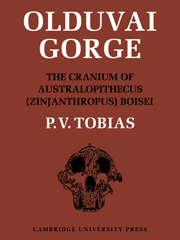Book contents
- Frontmatter
- Contents
- List of text-figures
- List of plates
- List of tables
- Introductory Note
- Foreword
- Editor's Note
- Acknowledgements
- I Introduction
- II Preservation and reconstruction of the cranium
- III The cranial vault
- IV The basis cranii externa
- V Certain critical angles and indices of the cranium
- VI The interior of the calvaria
- VII The thickness of the cranial bones
- VIII The endocranial cast of Zinjanthropus
- IX Metrical characters of the calvaria as a whole
- X The structure of the face
- XI The pneumatisation of the Zinjanthropus cranium
- XII The dental arcade and the palate
- XIII The pattern of dental attrition and occlusion, with comments on enamel hypoplasia
- XIV The size of individual teeth, absolute and relative
- XV The size of the dentition as a whole
- XVI The crown shape index of the teeth
- XVII The morphology of the teeth
- XVIII Summary of cranial and dental features of Zinjanthropus
- XIX The taxonomic status of Zinjanthropus and of the australopithecines in general
- XX The cultural and phylogenetic status of Australopithecus boisei and of the australopithecines in general
- References
- Index of persons
- Index of subjects
- Plate section
- Frontmatter
- Contents
- List of text-figures
- List of plates
- List of tables
- Introductory Note
- Foreword
- Editor's Note
- Acknowledgements
- I Introduction
- II Preservation and reconstruction of the cranium
- III The cranial vault
- IV The basis cranii externa
- V Certain critical angles and indices of the cranium
- VI The interior of the calvaria
- VII The thickness of the cranial bones
- VIII The endocranial cast of Zinjanthropus
- IX Metrical characters of the calvaria as a whole
- X The structure of the face
- XI The pneumatisation of the Zinjanthropus cranium
- XII The dental arcade and the palate
- XIII The pattern of dental attrition and occlusion, with comments on enamel hypoplasia
- XIV The size of individual teeth, absolute and relative
- XV The size of the dentition as a whole
- XVI The crown shape index of the teeth
- XVII The morphology of the teeth
- XVIII Summary of cranial and dental features of Zinjanthropus
- XIX The taxonomic status of Zinjanthropus and of the australopithecines in general
- XX The cultural and phylogenetic status of Australopithecus boisei and of the australopithecines in general
- References
- Index of persons
- Index of subjects
- Plate section
Summary
On 15 August 1959 the first announcement of the discovery of a new fossil cranium from Olduvai appeared in Nature (Leakey, 1959a). A week later, on Saturday 22 August 1959, at the formal opening ceremony of the fourth Pan-African Congress on Prehistory in Léopoldville, Dr L. S. B. Leakey publicly announced to the astonished and enthusiastic delegates more details of the important new specimen (Tobias, 1960a). He reiterated his view, expressed already in Nature, that the big-toothed cranium was that of a young male, representing a new genus of the subfamily Australopithecinae. To this genus he gave the name Zinjanthropus, Zinj being ‘the ancient name for East Africa as a whole’. He enumerated twenty features in which he claimed the new specimen differed from members of either of two previously-recognised australopithecine genera, Australopithecus and Paranthropus. He went on to designate the species as Zinjanthropus boisei sp.nov., the specific name being in honour of Mr Charles Boise, whose generous financial help had made the discovery possible. Leakey's (1959a) preliminary diagnosis of its specific features reads as follows: ‘A species of Zinjanthropus in which the males are far more massive than the most massive male Paranthropus. The face is also excessively long. Males have a sagittal crest, at least posteriorly. Upper third molars smaller than the second.’
Leakey stressed the tentative nature of his generic and specific diagnosis, recognising that, if and when further material were found, ‘the diagnosis will need both enlarging and possibly modifying’.
- Type
- Chapter
- Information
- Olduvai Gorge , pp. 1 - 5Publisher: Cambridge University PressPrint publication year: 1967
- 7
- Cited by

